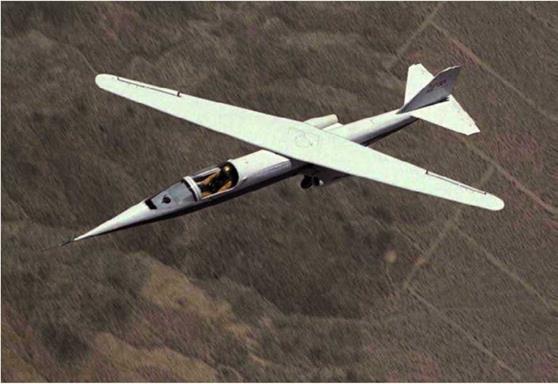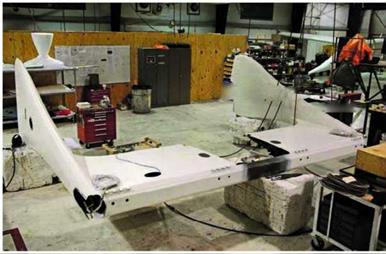Wings
The design of the wings had to take into consideration more factors than most other winged aircraft must consider. The wings of SpaceShipOne had to perform from subsonic to supersonic, withstand reentry into Earth’s atmosphere, and incorporate the mechanism of movable wings. No other winged vehicle has had to tackle all these at the same time.
Swept wings, which look like delta wings with the wingtips cut off, are attached high on the fuselage. This shape was required for supersonic flight. A tail boom with an outboard horizontal stabilizer is mounted to each wingtip.
The wings have an airfoil shape, but a hinge runs along the full length of the wingspan. The hinge allows the aft section of the wings to pivot up for the feather maneuver and back down after reentry. The forward wing sections, which are roughly the front two-thirds of each wing, do not move.
The wing area is approximately 160 square feet (15 square meters) and the wingspan is 16.4 feet (5.0 meters). However, since the horizontal stabilizers of the tail booms extend out farther than the wings, the width is 27 feet (8.2 meters).
The aspect ratio of the wing is 1.7, which is very low compared to the high aspect ratios of the long, thin wings of sailplanes. For traditional gliders, the lift characteristics are a key design factor. But for SpaceShipOne, it requires only enough lift to be able to point its nose upward during rocket-powered ascent in the atmosphere and to be able to glide back after reentry to the landing site for a safe touchdown.
There are two main spars that each run through the wing from tip to tip. One spar goes in front of the oxidizer tank, and one goes behind it, which can be seen in figure 4.11.

 г л
г л
Fig. 4.13. NASA had designed the Ames-Dryden-1 (AD-1) to explore the use of an oblique wing that could pivot during flight. During takeoff, the AD-1’s wing was perpendicular to the fuselage, like a traditional aircraft. In order to evaluate fuel efficiency, it was possible to pivot the wing to a maximum of 60 degrees, as shown in this photograph. NASA contracted Burt Rutan’s RAF to analyze design and loading characteristics. NASA-Dryden Flight Research Center
v__________________ J
“The wing is not tapered in total thickness,” Rutan said. “It is as thick at the tip as it is at the root. It has to do with meeting the stiffness to support the boom. And of course for the hinge line of the boom, it has to be a perfectly straight line or it would bind.”
There are no control surfaces on the leading or trailing edges of the wings like other aircraft. Wings on most aircraft also store fuel. But since fuel is stored in the rocket engine itself, which runs through the fuselage, and the oxidizer is in a large tank behind the cockpit, the wings have plenty of room to fit other components and systems, as shown in figure 4.12.










